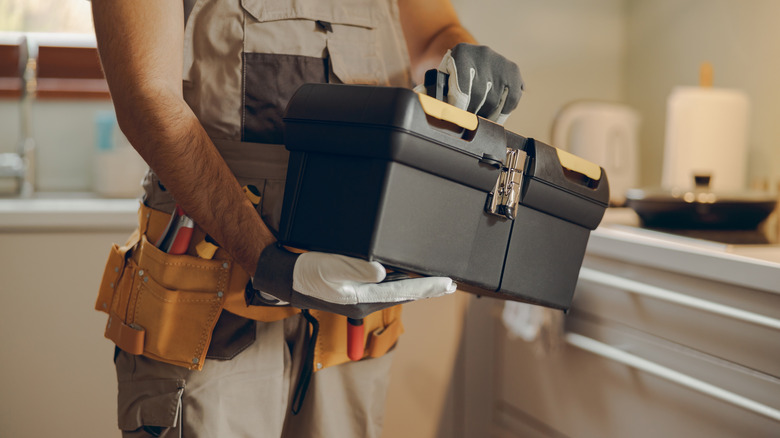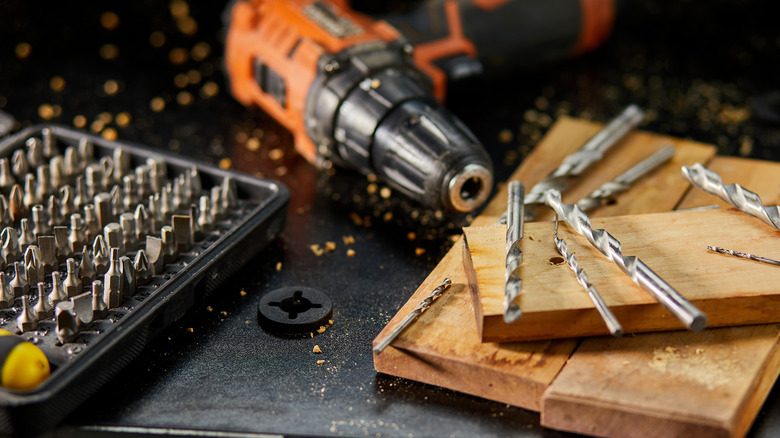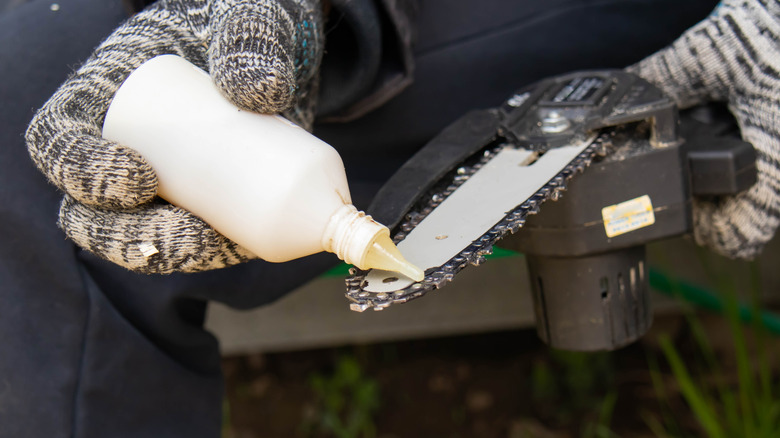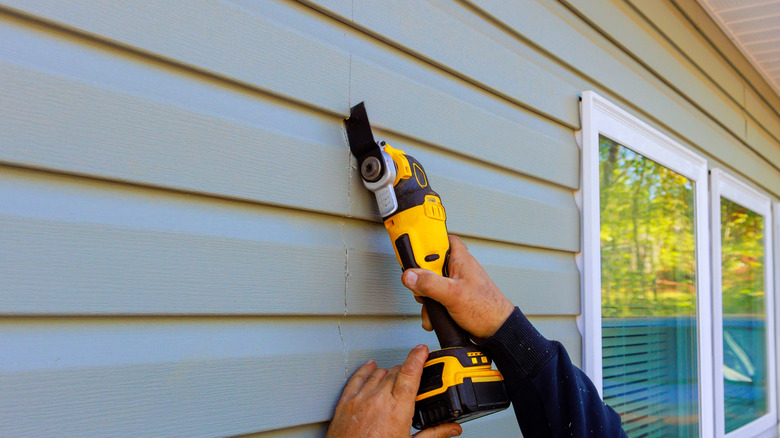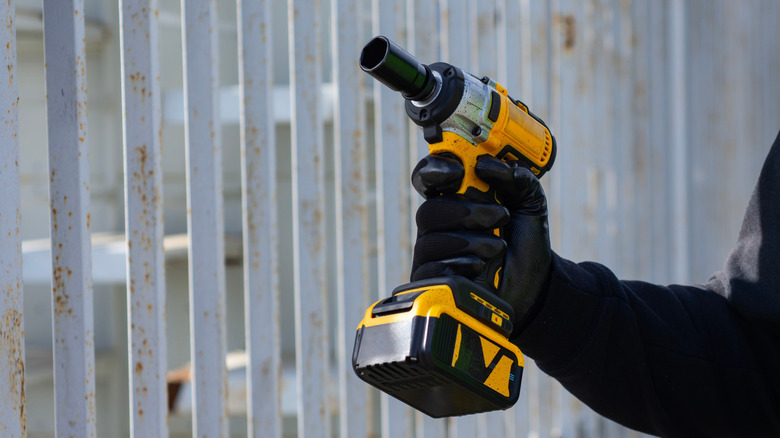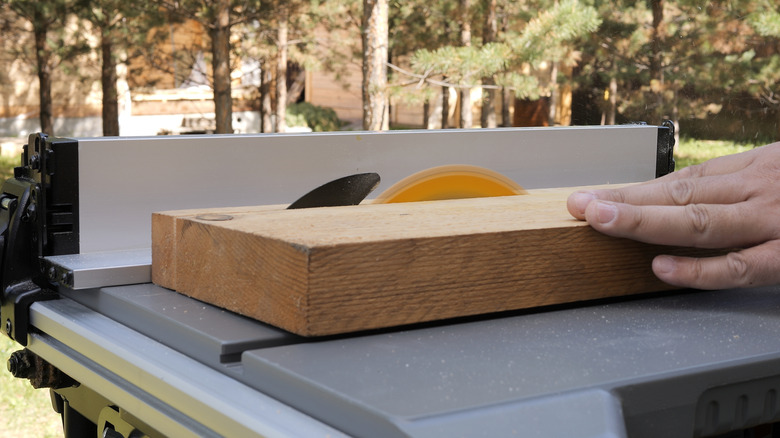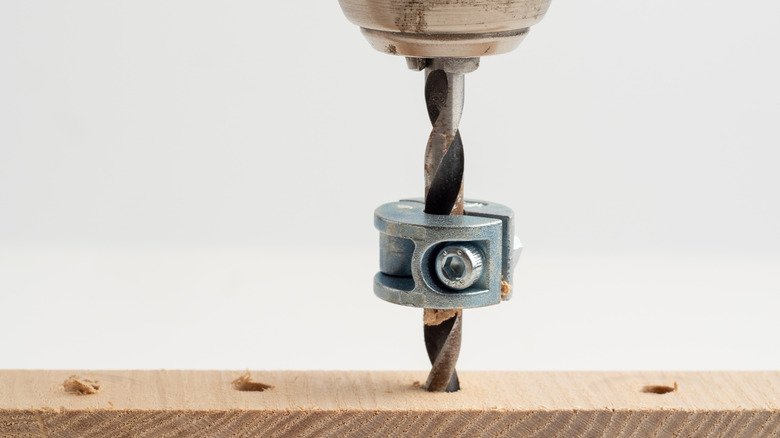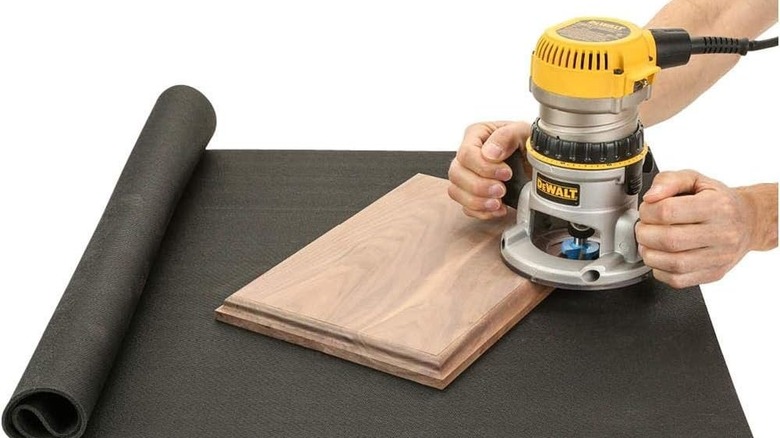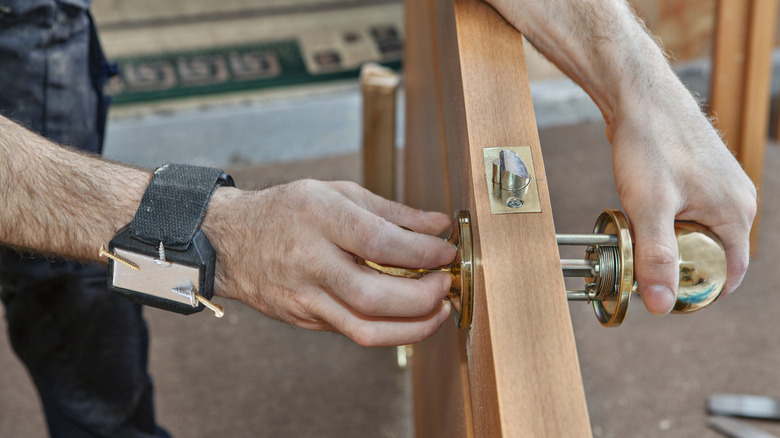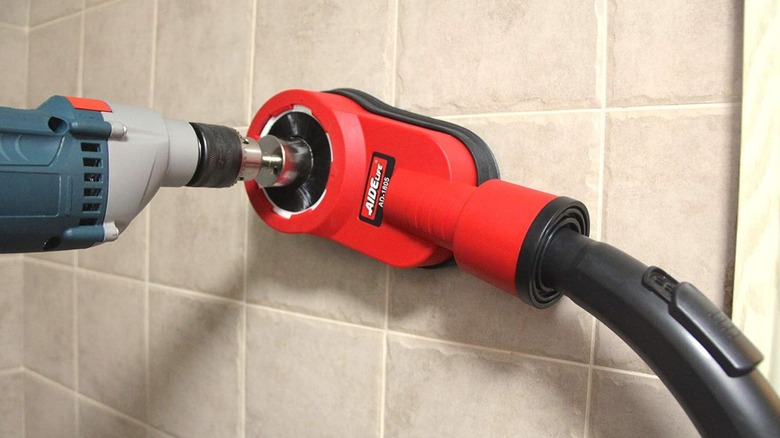11 Power Tool Accessories Every Homeowner Should Have In Their Toolbox
We may receive a commission on purchases made from links.
Power tools make many home improvement and maintenance tasks easier, allowing homeowners to tackle more DIY projects on their own. That extra boost of power — whether from a battery or from being plugged into a wall — enables you to drill, saw, drive, and hammer like a pro. However, even if you have a large collection of power tools, you might not be as fully prepared as you think you are. Beyond those must-have power tools, having the right accessories is crucial.
The best power tool accessories allow you to get the most out of your tools. They can make them safer to use, help ensure an easier cleanup process, and increase your efficiency and precision. So, just which accessories should you consider adding to your toolbox to reap these benefits? We've pulled together a list of several top options for you to consider. Read through our recommendations, and you'll be ready to get your toolbox stocked for your next DIY or home maintenance project.
Drill bits will come in handy for everything from quick repairs to large projects
Even if you have one of the top-rated drills for your home projects, you won't be able to use it to its full advantage without the right drill bits. There are actually several different types, and knowing which drill bit to choose for each project is critical if you want to ensure that everything goes smoothly. Most basic drill bit sets, such as this 14-piece Titanium Drill Bit Set from Makita, include twist bits. These bits can be used to drill holes in a variety of materials, including wood, plastic, ceramic, and metal. Sets include bits in a range of diameters to match the varying needs of each project (though some sets will have a wider range and more size options than others).
A screwdriver drill bit is another accessory that homeowners may find very useful. These tips, such as those found in the DeWalt 45-piece Screwdriver Bit Set, allow you to use your power drill to tighten and loosen screws, greatly simplifying a range of tasks. Most sets will include several screwdriver head styles. However, some have more options than others. So, if you're looking for something specific, be sure to pay close attention as you shop.
While these two types of drill bits are likely the most useful for the average homeowner, they only scratch the surface of what's available. There are several more types that are specifically designed for working with specific materials, such as glass, tile, or concrete, or for specific projects, such as assembling cabinets.
Extra batteries (and chargers) are a must if you don't want your tools to die in the middle of a job
Cordless power tools offer a range of advantages over their corded counterparts. Because they're battery-powered, you don't need to make sure there's an outlet nearby or deal with a cord getting in the way. Plus, moving these tools around is generally easier, and you're better able to get into tight spaces. However, with cordless tools, your work time is limited by the life of the battery. Instead of just accepting that you'll have to stop and wait for a battery to charge, plan ahead and purchase extra batteries. This way, you'll be able to swap out the dead one for a fresh one and keep on working.
Some manufacturers, such as DeWalt and Ryobi, offer a line of power tools that are compatible with the same battery. Purchasing products from a single line can help you keep your overall costs down. This allows you to share batteries across tools, so you only need to purchase a few additional backups. As for how many spares you should keep in your toolbox, that answer will likely depend on the type of projects you complete. If you only do relatively basic DIY tasks, then one backup may be sufficient. However, if you tackle more involved home maintenance tasks or want to be able to keep working for hours at a time, then you may want to add a few additional battery backups to your cart.
Don't forget to keep lubricants on hand to keep tools operating at peak performance
Power tools can be pricey. Some require a significant investment. If you want to protect your investment, then it's essential to give your tools the care they need. And, part of that care involves keeping them well lubricated. Lubricating is important for more reasons than you might guess. One of the most important is to keep friction under control. Applying a lubricant, such as WD-40 Original Formula, will help components glide smoothly so the tool can operate properly.
This thin film that the lubricant forms will also help reduce how much energy the tool requires for operation, potentially extending its useful life. One other key reason to keep your power tools well-lubricated is to minimize the chances of them getting corroded. When properly lubricated, the tools will have a barrier that prevents water from reaching the metal components, thus keeping them from rusting.
Keep some attachments on hand for your multi tool
Multi-tools, sometimes also called oscillating tools, are as versatile as their name suggests. Products like the DeWalt Oscillating Tool and the WorkPro Oscillating Tool Kit can help you accomplish a range of tasks. However, you'll need the right attachments in order to take advantage of everything they can do.
The best attachments for your multi-tool will vary depending on the type of projects you want to use it for. For example, you can find various cutting blades that are designed for use with specific materials, including wood, PVC, and metal. There are also different styles of cutting blades for making different types of cuts. For example, while segmented blades are better for linear cuts, plunge cut blades will deliver more precision and allow you to cut deeper into a surface. You can also find multi tool attachments that will allow the handheld device to function as a sander or let you use it to scrape off debris and gunk (such as caulk residue).
Attachments can also help you get more out of your impact driver
The more attachments and accessories you have for your impact driver, the more versatile the tool will be. Keep in mind, you shouldn't use regular drill bits because of the additional force that will be put on them with an impact driver. So, make sure that anything you purchase is impact-rated or you may end up with broken bits.
As with cordless drills, there's a range of specialty attachments and accessories designed for use with impact drivers. These include nut setters, sockets, spade bits, and more. For a more basic set, you might consider the DeWalt Impact Driver Screwdriver Bit Set, which has 34 pieces. If you want even more versatility, you could spend a bit more to get the Milwaukee Shockwave 74-piece Impact Driver Bit Set. If you'd like to move around more freely or climb ladders with your impact driver, then you may consider getting a belt clip, such as the NÖHLSTER Locking Holster Tool Clip.
You'll need different types of table saw blades depending on the type of project you're completing
Using your table saw safely is crucial. And, one thing that many people overlook is how important it is to make sure that you're using the right type of blade for the project you're working on. Not only can the wrong blade damage a material it isn't designed to be used with, it could pose a safety risk if the material backfires or a piece of the blade breaks off when the saw is operating.
One type of blade that you might want to have on hand for your table saw is a ripping saw blade. Options like Freud's Heavy-Duty Rip Saw Blade are ideal for cutting natural wood, such as lumber or plywood, along the grain. It's best for quicker and less precise cuts, which you can come back and clean up later. A crosscut blade, like the FoxBC Thin Kerf Fine Finish Blade, on the other hand, will be the best choice if you need to makes precise cuts across the grain of the wood. If you want to combine the features of a ripping blade and a crosscut blade to complete various projects, however, you'll need a combination saw blade. Finally, consider a composite blade, like the Craftsman Table Saw Blade with Carbide Teeth, if you need to cut manmade materials, such as MDF.
Consider some cleaning attachments for your drill that will help you power through grime and more
When you think about the tools you will need when cleaning the kitchen or the bathroom, your mind probably goes to your toilet brush, steam cleaner, or mop, not your power drill. However, there are some special drill attachments that might change your way of thinking. You can buy sets of various cleaning brushes, such as the Holikme 6-pack Drill Brush Set, that can transform your drill into a handy tool for cleaning your oven, shower tile, toilet, and more. These brushes connect to your drill the same way that other drill bits and screwdriver attachments do. With the power of the drill behind them, the brushes will spin rapidly, allowing you to remove grime and other gunk with less elbow grease on your part.
In addition to cleaning brush sets, you can find other brush attachments for your power drill to assist with other types of tasks. For example, the DazSpirit Wire Brush Set can be used for rust removal, stripping paint, and polishing metal. The brushes in this set are made from carbon steel wire, giving them a much coarser texture than those you'll find in a set designed for more general-purpose cleaning.
Keep some depth stop collars for your drill bits to avoid making holes that are too deep
As you're trying to drill the perfect pilot hole, it is important to make sure that you don't push the bit too far into the wall. If the hole you drill ends up too deep, the screw you insert may not be able to properly support the weight of the object you hang on it. Fortunately, there is a simple attachment that you can use with your drill to make sure that you don't inadvertently make a hole too deep: a drill depth stop.
This is a special collar that you can attach to a drill bit. Simply position it at the desired length, and when you use the drill bit to make a hole, the collar will prevent it from going in any further than desired. You can find sets, such as the True Position Professional Stop Collar Set, that include depth stops to fit bits of varying widths.
Anti-vibration pads can help reduce noise when you're working with loud tools
When you're working with table saws, sanders, or other power tools, the vibrations they make can cause a lot of noise. These loud noises have the potential to damage your hearing. Beyond that, they can be annoying to you and others in close proximity to your work site. One thing that can help is an anti-vibration pad. As the name suggests, these are designed to reduce the vibrations caused by power tools and other machines, thus dampening the noise they make.
Using an anti-vibration pad, for example, is also a hack that can help keep your washing machine extra quiet. These pads can be made from different materials. One that you're likely to see used is rubber, like Shop Fox's Anti-Vibration Pad. Rubber is excellent at absorbing vibrations, which can help reduce how loud a tool or machine sounds when operating. Polyurethane and PVC (polyvinyl chloride) are two other materials that can help absorb vibrations and reduce the noise produced by power tools.
Stock a magnetic band to make sure you don't lose small pieces of hardware as you're working
If you complete a lot of DIY projects or home maintenance tasks that involve working with screws, nails, nuts, bolts, or other metal hardware, then you know how difficult it can be to avoid dropping all these small pieces as you're working. When you have multiple screws or nails to remove or insert, you always feel like you're going to lose those that you're trying to hold or rest on the shelf of the ladder. Well, there's a simple (and affordable) accessory that can make your life a lot easier: a magnetic wristband.
Magnetic wristbands, like the RAK Magnetic Wristband, attach around your wrist and provide a convenient spot to hold all that extra hardware that you're dealing with. The metal screws, nails, washers, and other pieces are attracted to the strong magnets, preventing them from sliding off as you work. When you're ready for a certain piece, you can simply pull it off the wristband.
Dust collection accessories can improve air quality as you work and reduce cleanup after finishing a job
When you're working with a sander, cutting wood, or even drilling into drywall, it can generate a lot of dust. Not only can all this dust increase the time you spend cleaning up after you've finished a job, but it can also threaten your health. Exposing yourself to so much sawdust or drywall dust can pose a variety of risks, including irritation of the throat, eyes, or nose, respiratory problems, and skin irritation.
Therefore, doing what you can to minimize how much dust is released into the air is important. You can consider creating a DIY cyclone dust collector to keep your workspace clean, but you can also purchase accessories specifically designed for this task. Consider the Disston Blu-Mol Hole Saw Dust Bowl if you need to drill into the ceiling. The dome shape will collect the dust as you work, preventing it from spreading through the air. The Bosch SDS-Max Hammer Dust Collection Attachment is designed to be used with hammer drills to stop dust from flying when you're cutting into various surfaces, including concrete and bricks. And the DustopperPRO is designed to connect with table saws and other tools. One end hooks up to your shop vac to provide suction, but the dust is trapped in a bucket to prevent it from clogging the vacuum's filters.
